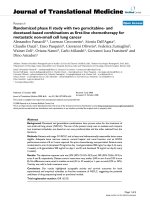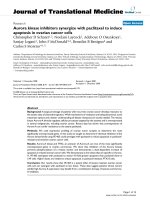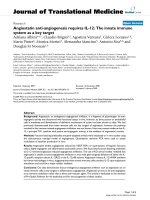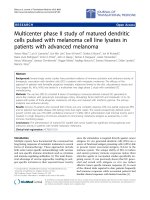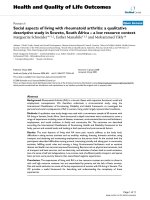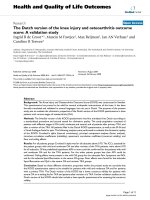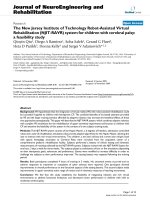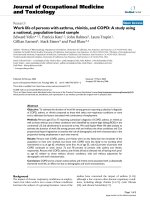báo cáo hóa học:" Randomized phase II study with two gemcitabine- and docetaxel-based combinations as first-line chemotherapy for metastatic non-small cell lung cancer" docx
Bạn đang xem bản rút gọn của tài liệu. Xem và tải ngay bản đầy đủ của tài liệu tại đây (262.83 KB, 8 trang )
BioMed Central
Page 1 of 8
(page number not for citation purposes)
Journal of Translational Medicine
Open Access
Research
Randomized phase II study with two gemcitabine- and
docetaxel-based combinations as first-line chemotherapy for
metastatic non-small cell lung cancer
Alessandro Passardi*
1
, Lorenzo Cecconetto
1
, Monia Dall'Agata
2
,
Claudio Dazzi
3
, Enzo Pasquini
4
, Giovanni Oliverio
4
, Federica Zumaglini
3
,
Wainer Zoli
1
, Oriana Nanni
2
, Carlo Milandri
1
, Giovanni Luca Frassineti
1
and
Dino Amadori
1
Address:
1
Istituto Scientifico Romagnolo per lo Studio e la Cura dei Tumori, Meldola, Italy,
2
Istituto Oncologico Romagnolo, Forlì, Italy,
3
Department of Oncology, Santa Maria delle Croci Hospital, Ravenna, Italy and
4
Department of Oncology, Infermi Hospital, Rimini, Italy
Email: Alessandro Passardi* - ; Lorenzo Cecconetto - ;
Monia Dall'Agata - ; Claudio Dazzi - ; Enzo Pasquini - ;
Giovanni Oliverio - ; Federica Zumaglini - ; Wainer Zoli - ;
Oriana Nanni - ; Carlo Milandri - ; Giovanni Luca Frassineti - ;
Dino Amadori -
* Corresponding author
Abstract
Background: Docetaxel and gemcitabine combinations have proven active for the treatment of
non-small cell lung cancer (NSCLC). The aim of the present study was to evaluate and compare
two treatment schedules, one based on our own preclinical data and the other selected from the
literature.
Methods: Patients with stage IV NSCLC and at least one bidimensionally-measurable lesion were
eligible. Adequate bone marrow reserve, normal hepatic and renal function, and an ECOG
performance status of 0 to 2 were required. No prior chemotherapy was permitted. Patients were
randomized to arm A (docetaxel 70 mg/m
2
on day 1 and gemcitabine 900 mg/m
2
on days 3–8, every
3 weeks) or B (gemcitabine 900 mg/m2 on days 1 and 8, and docetaxel 70 mg/m2 on day 8, every
3 weeks).
Results: The objective response rate was 20% (95% CI:10.0–35.9) and 18% (95% CI:8.6–33.9) in
arms A and B, respectively. Disease control rates were very similar (54% in arm A and 53% in arm
B). No differences were noted in median survival (32 vs. 33 weeks) or 1-year survival (33% vs. 35%).
Toxicity was mild in both treatment arms.
Conclusion: Our results highlighted acceptable activity and survival outcomes for both
experimental and empirical schedules as first-line treatment of NSCLC, suggesting the potential
usefulness of drug sequencing based on preclinical models.
Trial registration number: IOR 162 02
Published: 31 October 2008
Journal of Translational Medicine 2008, 6:65 doi:10.1186/1479-5876-6-65
Received: 7 July 2008
Accepted: 31 October 2008
This article is available from: />© 2008 Passardi et al; licensee BioMed Central Ltd.
This is an Open Access article distributed under the terms of the Creative Commons Attribution License ( />),
which permits unrestricted use, distribution, and reproduction in any medium, provided the original work is properly cited.
Journal of Translational Medicine 2008, 6:65 />Page 2 of 8
(page number not for citation purposes)
Background
Lung cancer remains the leading cause of cancer-related
mortality in the western world. Non-small cell lung cancer
(NSCLC) accounts for approximately 80% of these tho-
racic malignancies, with 1.2 million new cases diagnosed
worldwide each year [1]. The vast majority of NSCLC
patients present with advanced, inoperable disease and
are, therefore, candidates for palliative chemotherapy. The
role of chemotherapy as an integral part of the treatment
of lung cancer has grown significantly, especially in the
last few years. In metastatic disease it prolongs survival
and improves quality of life in patients with good per-
formance status, and also appears to provide symptomatic
improvement in patients with decreased performance sta-
tus [2,3].
Among active chemotherapeutic agents, cisplatin has his-
torically been considered the most effective in both the
palliative treatment of metastatic disease and the com-
bined-modality therapy of locally advanced disease. In
stage IV NSCLC, cisplatin-based chemotherapy results in
improved survival with respect to supportive care alone.
In an analysis of more than 2,000 patients with advanced
NSCLC treated in Southwest Oncology Group (SWOG)
trials, cisplatin emerged as an independent variable of
improved survival.
Over the last decade, a number of new chemotherapeutic
agents that are active in NSCLC have undergone clinical
development, such as the taxanes, irinotecan, vinorelbine
and gemcitabine. Phase II trials of these new agents in
combination with platinum have shown impressive
response and survival results, leading to their widespread
clinical application. Subsequent randomized trials com-
paring these novel regimens with cisplatin alone or with
"older" platinum combinations have generally confirmed
a therapeutic advantage for the new agent-platinum
schedules, albeit with a lesser improvement in survival
than that indicated by earlier phase II studies [4-7].
Although in the recent past several randomized studies
have compared these new doublets, no important differ-
ences have emerged, and so all tested doublets can be con-
sidered as reasonable choices for patients with advanced
NSCLC [8-10]. Recent randomized trials have also com-
pared the efficacy of platinum-free and platinum-based
regimens, showing equivalence [11-14]. However, plati-
num-based polychemotherapy remains the standard
treatment for metastatic disease.
We evaluated the preclinical activity of docetaxel and
gemcitabine in 2 established NSCLC cell lines (RAL,
CAEP) [15]. The sequence docetaxel→gemcitabine pro-
duced only a weak synergistic interaction in RAL but a
strong synergism in CAEP cells. The synergistic interaction
increased in both cell lines after a 48-hour washout
between drug administrations. Conversely, simultaneous
treatment induced an antagonistic effect in both cell lines
and the sequential scheme gemcitabine→docetaxel pro-
duced a weak synergistic effect only in RAL cells. The syn-
ergistic activity of docetaxel→48-hour
washout→gemcitabine was confirmed in 11 out of 14 pri-
mary cultures. We also investigated the activity of 2
administrations of gemcitabine after docetaxel in NSCLC
cell lines and found that a 48-hour washout between the
2 administrations of gemcitabine resulted in a stronger
cytotoxic activity than that obtained with a 72-hour wash-
out [16].
On the basis of the data obtained from our previous phase
I clinical study of advanced NSCLC in which escalating
doses of both drugs (docetaxel 50–70 mg/m
2
on day 1,
gemcitabine 800–1200 mg/m
2
on days 3–8, every 21
days) were used, we defined the optimal dose-treatment:
docetaxel 70 mg/m
2
on day 1 and gemcitabine 900 mg/m
2
on days 3–8 [17,18].
In the present randomized phase II trial, we evaluated the
activity of this new treatment schedule together with an
empirical schedule selected from the literature: gemcitab-
ine 900 mg/m
2
on days 1 and 8 and docetaxel 70 mg/m
2
on day 8, every 3 weeks.
Materials and methods
Eligibility Criteria
Patients with histologically and/or cytologically con-
firmed stage IV NSCLC; age ≥ 18 years; Eastern Co-opera-
tive Oncology Group (ECOG) Performance Status 0–2;
life expectancy > 12 weeks; adequate hepatic and renal
function: creatinine and total bilirubin ≤ 1.5 × upper limit
of normal, AST and ALT ≤ 3 × upper limit of normal (≤ 5
in patients with liver metastases); adequate bone marrow
reserve: absolute neutrophil count ≥ 1.5 × 10
3
/L, platelet
count ≥ 100 × 10
3
/L, hemoglobin ≥ 9 g/dl. Patients were
required to have at least one lesion that was bidimension-
ally measurable according to WHO criteria.
Exclusion Criteria
Active serious infections or severe concomitant diseases
(at the discretion of the investigator); known central nerv-
ous system tumors, including metastatic brain disease;
pregnancy or breast-feeding; previous or concurrent
malignancy other than lung cancer, with the exception of
non melanoma skin cancer or curatively treated carci-
noma in situ of the uterine cervix; previous chemotherapy
in an adjuvant setting or for metastatic disease. No other
anticancer treatments, with the exception of bisphospho-
nates and palliative radiotherapy of non target lesions,
were allowed.
Journal of Translational Medicine 2008, 6:65 />Page 3 of 8
(page number not for citation purposes)
All patients gave written informed consent to receive treat-
ment and the study was examined and approved by the
Ethics Committee of the Local Health and Social Services
of each participating center, in accordance with the ethical
standards laid down in the 1964 Declaration of Helsinki.
Treatment Plan
Patients who fulfilled all inclusion and exclusion criteria
were randomized to receive the experimental regimen
(arm A), defined in the phase I trial as docetaxel 70 mg/
m
2
on day 1 and gemcitabine 900 mg/m
2
on days 3–8, or
the empirical regimen (arm B), consisting of gemcitabine
900 mg/m
2
on days 1 and 8, and docetaxel 70 mg/m
2
on
day 8. Both schedules were repeated every 21 days and
administered on an outpatient basis.
Patients received antiemetics and granulocyte colony-
stimulating factor at the physicians' discretion. Palliative
and supportive treatment for tumor-related symptoms
was administered as required. All patients received intra-
venous (i.v.) or intramuscular (i.m.) dexamethasone 8 mg
bid 24 hours before each infusion of docetaxel up to a
total of six doses.
Treatment was given for a maximum of 8 cycles and was
discontinued in cases of unacceptable toxicity, disease
progression, patient refusal or when, in the judgement of
the investigator, a different treatment would be more
appropriate for the patient's overall clinical status.
Dose reductions were made in the presence of hematolog-
ical toxicity (ANC < 0.5 × 10
9
/L and/or platelet count < 50
× 10
9
/L lasting more than 7 days) or grade 3 non hemato-
logical toxicity (other than alopecia and nausea/vomit-
ing). Patients were taken off study if grade IV febrile
neutropenia, thrombocytopenia with severe bleeding, or
any grade IV non hematological toxicity occurred.
Statistical Plan
The primary endpoint of the study was to assess the over-
all response rate (ORR) in patients treated in each sepa-
rately analyzed arm. Secondary endpoints were toxicity,
duration of response, time to progression (TTP) and over-
all survival (OS).
This randomized phase II trial can be considered as two
simultaneous phase II studies: the sample size for each
arm was calculated using Simon's one-stage design with a
5% α error and 10% β error. Assuming a poor ORR P0 =
10% and an acceptable objective response rate P1 = 30%,
it was planned to recruit 33 patients. If the response
number was ≥ 7 in each arm, the combination would be
considered active and warrant further investigation.
Efficacy and toxicity analyses were performed on all
patients who received at least one dose of study treatment.
Statistical analysis included simple descriptive statistics.
ORRs were calculated and 95% confidence intervals (95%
CI) were derived from the exact binomial distribution.
Kaplan-Meyer estimations were used to evaluate response
duration, progression-free survival (PFS) and OS. No for-
mal statistical test was performed. Block balanced rand-
omization lists were performed for each center.
Evaluation of Activity and Toxicity
Screening evaluation included full medical history, physi-
cal and neurological examinations, tumor measurements
(by CT and bone scans), cardiac function examination
(ECG), hematological and biochemistry analyses, and
other evaluations if clinically indicated.
Treatment activity was assessed every two months accord-
ing to WHO criteria. A complete response (CR) was
defined as the disappearance of all lesions and no appear-
ance of new disease for at least 4 weeks. Partial response
(PR) was defined as a reduction by at least 50% in the sum
of the products of the two longest diameters of all lesions,
maintained for at least 4 weeks with no appearance of new
disease. CR + PR was rated as the overall response rate. Sta-
ble disease (SD) was defined as a less than 50% reduction
or less than 25% increase in the sum of the products of the
two perpendicular diameters of all measured lesions, with
no appearance of new disease. Progressive disease (PD)
was an increase of more than 25% in the size of target
lesions, or the appearance of an unequivocal new lesion.
Toxicity was evaluated according to National Cancer Insti-
tute Common Toxicity Criteria version 2.0 after each treat-
ment cycle. Hematochemical assays testing
hematological, liver and renal toxicity were performed on
days 1, 8 and 15 of each cycle.
Response duration was defined as the interval between
the dates of first documented CR, or study entry in the
case of PR, and first documented sign of disease progres-
sion. PFS and TTP were measured from the date of study
entry until the date of disease progression or death, and
survival was measured from the date of study entry until
the date of death from any cause.
The actual cumulative dose for each drug was calculated
and patients were classified into 4 groups (< 50%, 50–
69%, 70–84%, > 85%) on the basis of the percentage of
the actual cumulative dose with respect to the planned
cumulative dose.
Similarly, relative dose intensity (RDI) was defined as the
total cumulative dose over time (if a patient received
Journal of Translational Medicine 2008, 6:65 />Page 4 of 8
(page number not for citation purposes)
chemotherapy according to the protocol without any dose
reduction or delay, RDI = 100%). The RDI for each drug
was calculated and patients were classified into 4 groups
(< 50%, 50–69%, 70–84%, > 85%) on the basis of the
percentage of the RDI with respect to the planned dose
intensity.
Results
Patient Characteristics
Between November 2001 and December 2005, a total of
81 patients with first-line stage IV NSCLC were recruited
from the Medical Oncology Departments of Forlì, Rimini
and Ravenna hospitals (Istituto Oncologico Romagnolo
group). Baseline patient demographics are summarized in
Table 1. The two treatment groups were well balanced for
gender, age, performance status, disease stage, and histol-
ogy. Of the 81 enrolled patients, four did not receive study
treatment because of ineligibility (1 patient had severe
renal dysfunction and 3 patients withdrew consent).
Treatment Activity
Of the 77 treated patients, 69 (89.6%) were assessable for
tumor response (35 in arm A, 34 in arm B): one patient
withdrew consent after the first treatment cycle, five were
not assessable for response because of treatment discon-
tinuation due to severe toxicity during the first cycle, and
two were taken off study before evaluation because of seri-
ous adverse events, which were not considered treatment-
related.
Tumor response rates were 20% (95% CI 10.0 – 35.9) in
arm A and 18% (95% CI 8.6 – 33.9) in arm B (Table 2).
Disease control, i.e. CR, PR, or stable disease, was
achieved in 54% of arm A patients and 53% of arm B
patients.
The median response duration was 20 weeks (range 14 –
36) and 30 weeks (range 27 – 105) in arms A and B,
respectively. The median TTP in arm A was 18 weeks (95%
CI 12 – 21) and 14 weeks (95% CI 8 – 27) in arm B (Fig-
ure 1A). Median survival in arms A and B was 32 weeks
(95% CI 27 – 49) and 33 weeks (95% CI 24 – 54), and 1-
year survival was 33% (95% CI 17 – 48) and 35% (95%
CI 19 – 51), respectively (Figure 1B).
Treatment Safety and Toxicity
A total of 292 cycles (149, arm A; 143, arm B) were admin-
istered during the study, with a median of 3 cycles per
patient (range 1–8 cycles) (Table 3). With regard to the
actual cumulative dose in arm A, 85% of patients received
> 85% of docetaxel, while the remaining 15% received a
cumulative dose of more than 70% of that planned. In
arm B, 74% of patients received > 85% of the planned
Table 1: Patient and disease characteristics at baseline
Arm A (n = 40) Arm B (n = 41)
n (%) n (%)
Received treatment 39 (97.5) 38 (92.7)
Age, years
Median (range) 63 (35–77) 63 (48–74)
Gender
Male 33 (82.5) 32 (78.0)
Female 7 (17.5) 9 (22.0)
ECOG performance status
0 19 (47.5) 20 (48.8)
1 16 (40) 16 (39)
2 4 (10) 3 (7.3)
Missing 1 (2.5) 2 (4.9)
Histological classification
Adenocarcinoma 22 (55) 23 (56.1)
Epidermoidal carcinoma 14 (35) 12 (29.3)
Other NSCLC 4 (10) 6 (14.6)
Site of disease
Lung ± lymph nodes 14 (35) 14 (34.1)
Lung and 1 metastatic site 12 (30) 15 (36.6)
Lung and ≥ 2 metastatic sites 9 (22.5) 10 (24.4)
Extra-pulmonary disease 5 (12.5) 2 (4.9)
Previous surgery for neoplastic disease
Yes 4(10)5(13)
Palliative 4 2
Curative 0 3
No 35 (90) 33 (87)
Journal of Translational Medicine 2008, 6:65 />Page 5 of 8
(page number not for citation purposes)
dose, 18% received between 50 and 84%, and only 8%
were administered < 50% of the planned dose.
With regard to gemcitabine, 44% of arm A patients
received > 85% of the scheduled dose, 54% received 50–
84%, and only 3% were given < 50%. In arm B, 76% of
patients were administered > 85% of the planned dose,
while the remaining 24% received 50–84%.
Docetaxel RDI was ≥ 85% in 59% and 68%, and < 50% in
only 5% and 8% of arm A and B patients, respectively.
Gemcitabine RDI was ≥ 85% in 33% and 74%, and < 50%
in 23% and 0% of arm A and B patients, respectively. Eval-
uating overall relative dose intensity, ≥ 85% was received
by 44%, 84–70% by 21% and 69–50% by 21% of arm A
patients. In arm B, ≥ 85% was received by 74%, 84–70%
by 5% and 69–50% by 21% of patients.
All 77 patients were assessable for treatment safety. Toxic-
ities observed per patient and per cycle are reported in
Table 4. As expected, the most important toxicity was
hematological. Arm A patients had higher grade 3 and 4
Table 2: Best tumor response
Arm A Arm B
n(%)n(%)
Partial response 7(20)6(18)
No change 12 (34) 12 (35)
Progressive disease 16 (46) 16 (47)
Time to progression (TTP) (A) and overall survival (OS) (B)Figure 1
Time to progression (TTP) (A) and overall survival (OS) (B).
0 4 8 1216202428323640444852
Weeks
0
0.2
0.4
0.6
0.8
1
TTP
Patients Events (%)
Arm A 35 33 (94.3)
Arm B 34 32 (94.1)
A
0 4 8 12 16 20 24 28 32 36 40 44 48 52
Weeks
0
0.2
0.4
0.6
0.8
1
Survival
Patients Events (%)
Arm A 35 29 (82.9)
Arm B 34 31 (91.2)
B
Journal of Translational Medicine 2008, 6:65 />Page 6 of 8
(page number not for citation purposes)
leukopenia (33.3%) and neutropenia (53.8%) and, and
more frequent febrile neutropenia (7.6%) than those in
arm B (10.5%, 30.3% and 2.6%, respectively). There were
no cases of grade 4 anemia or thrombocytopenia in either
arm. Non hematological adverse events were rare and
mild: grade 4 toxicity was observed in two arm A patients
(1 diarrhea, 1 bowel occlusion) and in three arm B
patients (1 cardiotoxicity, 1 pulmonary edema, 1 hepato-
toxicity). One case of interstitial pneumonitiis occurred in
arm B. There were no toxic deaths.
Discussion
Platinum-based combination chemotherapy is currently
regarded as the gold standard of care for advanced
NSCLC. In a large meta-analysis published by the NSCLC
Collaborative Group in 1995, cisplatin-containing ther-
apy for advanced disease was shown to confer an absolute
survival gain of 10% at 1 year, and a modest 1.5-month
improvement in median survival compared with best sup-
portive care alone [2]. However, treatment options
remain limited as a result of the poor activity of cytotoxic
agents.
Docetaxel and gemcitabine have non-overlapping toxici-
ties and several combination regimens of these agents
have been evaluated in NSCLC. The every-3-week sched-
ules used consist of docetaxel 75–100 mg/m
2
on day 1 or
day 8 and gemcitabine 900–1000 mg/m
2
on days 1 and 8.
Response rates of 26–50% and a median overall survival
of 7–13 months have been reported in phase II trials [19-
23].
In the present study, we evaluated 2 different combina-
tions of these two agents in patients with non pretreated
metastatic disease. The experimental regimen was derived
from our in vitro investigation and subsequent dose-find-
ing study, the results of which indicated the safety and fea-
sibility of the sequential treatment [5]. The other schedule
was taken from a clinical scheme reported in the litera-
ture.
Our purpose was to analyze the activity and safety of both
schedules and to determine whether the preclinical results
would be confirmed in a clinical trial. The response rates
for both non-platinum doublets were (20% and 18%)
slightly lower than those historically observed among
advanced NSCLC patients with previously untreated dis-
ease and a good performance status. It must be pointed
out that we only recruited stage IV patients, consequently
those with the worst prognosis, and that this choice may
have influenced the study outcome. Both regimens had an
acceptable toxicity profile and the frequency of grade 3/4
toxicities did not preclude treatment administration in an
outpatient setting.
Table 3: Treatments administered
Arm A Arm B
Total number of cycles 149 148
Median number of cycles (min-max) 3 (1–8) 3 (1–6)
No. of delayed cycles (%) 22 (14.8) 9 (6.1)
Median dose intensity 0.78 0.86
Table 4: Toxicity of docetaxel and gemcitabine combinations per patient
Arm A
n = 39
Arm B
n = 38
Toxicity grade 2 3 4 2 3 4
Hematological n (%) N (%) n (%) n (%) n (%) n (%)
Leukopenia 6 (15) 9 (23) 4 (10) 3 (8) 2 (5) 2 (5)
Anemia 12 (31) 1 (3) 0 - 5 (13) 0 - 0 -
Thrombocytopenia 1 (3) 2 (5) 0 - 2 (5) 0 - 0 -
Neutropenia 3 (8) 7 (18) 14* (36) 6 (16) 4 (11) 7
†
(8)
Non hematological
Hepatotoxicity 4 (10) 3 (8) 0 - 5 (13) 3 (8) 1 (3)
Mucositis 5 (13) 3 (8) 0 - 2 (5) 0 - 0 -
Nausea 3 (8) 3 (8) 0 - 3 (8) 2 (5) 0 -
Vomiting 3 (8) 2 (5) 0 2 (5) 2 (5) 0 -
Diarrhea 7 (18) 3 (8) 1 (3) 5 (13) 0 - 0 -
Asthenia 8 (21)2 (5)0 -1 (3)2 (5)0 -
Alopecia 4 (10)2 (5)0 -0 -3 (8)0 -
Skin 5 (13)0 -0 -2 (5)0 -0 -
Other 8 (21) 3 (8) 1
§
3) (3) 8 (21) 0 - 2
‡
(5)
*3 febrile neutropenia;
§
bowel occlusion;
†
1 febrile neutropenia;
‡
1 cardiac toxicity, 1 pulmonary edema
Journal of Translational Medicine 2008, 6:65 />Page 7 of 8
(page number not for citation purposes)
Conclusion
Our results highlighted acceptable activity and survival
outcomes for both the experimental and empirical sched-
ules as first-line treatment. Nevertheless, in agreement
with previous studies, platinum-based chemotherapy
should currently be considered the reference regimen for
the first-line treatment of NSCLC. The docetaxel and gem-
citabine combination may be especially useful in patients
who have experienced intolerance to platinum, or who
may be more susceptible to platinum-related toxicity (e.g.
patients with pre-existing renal disease or neurotoxicity).
Further studies are now needed to evaluate gemcitabine –
docetaxel in combination with emerging molecular
agents showing therapeutic potential for advanced
NSCLC.
Abbreviations
NSCLC: non small cell lung cancer; TTP: time to progres-
sion; OS: overall survival; CR: complete response; PR: par-
tial response; SD: stable disease; PD: progressive disease;
PFS: progression-free survival.
Competing interests
The authors declare that they have no competing interests.
Authors' contributions
AP, GLF, CM, LC and DA conceived and designed the
study. LC, CD, GO, EP and CM were responsible for
patient care and data acquisition. FZ was in charge of
quality control and monitoring. MDA and ON were
responsible for data management and statistical analyses.
AP, GLF and DAM wrote the first draft of the manuscript.
WZ carried out the preclinical study. AP, DA and CM crit-
ically revised the manuscript for important intellectual
content. All authors reviewed and commented on the
final manuscript and approved the decision to submit it
for publication.
Acknowledgements
The Authors wish to thank Prof. Rosella Silvestrini for her invaluable scien-
tific contribution and Gráinne Tierney for editing the manuscript. Sup-
ported by Istituto Oncologico Romagnolo, Forlì, Italy. The funding
organization had no role in the design and conduct of the study; collection,
management, analysis, and interpretation of the data; and preparation,
review, or approval of the manuscript.
References
1. Parkin DM, Bray F, Ferlay J, Pisani P: Estimating the world cancer
burden: Globocan 2000. Int J Cancer 2001, 94:153-156.
2. Non-small Cell Lung Cancer Collaborative Group: Chemotherapy
in non small cell lung cancer: a meta-analysis using updated
data on individual patients from 52 randomized clinical tri-
als. BMJ 1995, 311:899-909.
3. Bunn PA, Kelly K: New chemotherapeutic agents prolong sur-
vival and improve quality of life in non-small cell lung cancer:
a review of the literature and future directions. Clin Cancer Res
1998, 4:1087-1100.
4. Le Chevalier T, Brisgand D, Douillard JY, Pujol JL, Alberola V, Monnier
A, Riviere A, Lianes P, Chomy P, Cigolari S: Randomized study of
vinorelbine and cisplatin versus vindesine and cisplatin ver-
sus vinorelbine alone in advanced non small cell lung cancer:
results of a European multicenter trial including 612
patients. J Clin Oncol 1994, 12:360-367.
5. Bonomi P, Kim K, Fairclough D, Cella D, Cella D, Kugler J, Rowinsky
E, Jiroutek M, Johnson D: Comparison of survival and quality of
life in advanced non-small-cell lung cancer patients treated
with two dose levels of paclitaxel combined with cisplatin
versus etoposide with cisplatin: results of an Eastern Coop-
erative Oncology Group trial. J Clin Oncol 2000, 18:623-631.
6. Giaccone G, Splinter TA, Debruyne C, Kho GS, Lianes P, van Zandw-
ijk N, Pennucci MC, Scagliotti G, van Meerbeeck J, van Hoesel Q, Cur-
ran D, Sahmoud T, Postmus PE: Randomized study of paclitaxel-
cisplatin versus cisplatin-teniposide in patients with
advanced non-small-cell lung cancer. The European Organi-
zation for Research and Treatment of Cancer Lung Cancer
Cooperative Group. J Clin Oncol 1998, 16:2133-2141.
7. Crino L, Scagliotti GV, Ricci S, De Marinis F, Rinaldi M, Gridelli C,
Ceribelli A, Bianco R, Marangolo M, Di Costanzo F, Sassi M, Barni S,
Ravaioli A, Adamo V, Portalone L, Cruciani G, Masotti A, Ferrara G,
Gozzelino F, Tonato M: Gemcitabine and cisplatin versus mito-
mycin, ifosfamide, and cisplatin in advanced non-small-cell
lung cancer: a randomized phase III study of the Italian Lung
Cancer Project. J Clin Oncol 1999, 17:3522-3530.
8. Schiller JH, Harrington D, Belani CP, Langer C, Sandler A, Krook J,
Zhu J, Johnson DH: Comparison of four chemotherapy regi-
mens for advanced non-small cell lung cancer. N Engl J Med
2002, 346:92-98.
9. Kelly K, Crowley J, Bunn PA Jr, Presant CA, Grevstad PK, Moinpour
CM, Ramsey SD, Wozniak AJ, Weiss GR, Moore DF, Israel VK, Liv-
ingston RB, Gandara DR: A randomized phase III trial of paclit-
axel plus cisplatin versus vinorelbine plus cisplatin in the
treatment of patients with advanced non-small cell lung can-
cer: a Southwest Oncology Group trial. J Clin Oncol 2001,
19:3210-3218.
10. Scagliotti GV, De Marinis F, Rinaldi M, Crino L, Gridelli C, Ricci S,
Matano E, Boni C, Marangolo M, Failla G, Altavilla G, Adamo V,
Ceribelli A, Clerici M, Di Costanzo F, Frontini L, Tonato M: Italian
Lung Cancer Project. Phase III randomized trial comparing
three platinum-based doublets in advanced non small-cell
lung cancer. J Clin Oncol 2002, 20:4285-4291.
11. Kosmidis P, Mylonakis N, Nicolaides C, Kalophonos C, Samantas E,
Boukovinas J, Fountzilas G, Skarlos D, Economopoulos T, Tsavdaridis
D, Papakostas P, Bacoyiannis C, Dimopoulos M: Paclitaxel plus car-
boplatin versus gemcitabine plus paclitaxel in advanced non-
small-cell lung cancer: a phase III randomized trial. J Clin Oncol
2002, 20:3578-3585.
12. Georgoulias V, Papadakis E, Alexopoulos A, Tsiafaki X, Rapti A,
Veslemes M, Palamidas P, Vlachonikolis I: Platinum-based and
non-platinum-based chemotherapy in advanced non-small
cell lung cancer: a randomised multicentre trial. Lancet 2001,
357:1478-1484.
13. Gridelli C, Gallo C, Shepherd FA, Illiano A, Piantedosi F, Robbiati SF,
Manzione L, Barbera S, Frontini L, Veltri E, Findlay B, Cigolari S, Myers
R, Ianniello GP, Gebbia V, Gasparini G, Fava S, Hirsh V, Bezjak A, Sey-
mour L, Perrone F: Gemcitabine plus vinorelbine compared
with cisplatin plus vinorelbine or cisplatin plus gemcitabine
for advanced non-small-cell lung cancer: a phase III trial of
the Italian GEMVIN Investigators and the National Cancer
Institute of Canada Clinical Trials Group. J Clin Oncol 2003,
21:3025-3034.
14. Smit EF, Van Meerbeeck J, Lianes P, Debruyne C, Legrand C, Schramel
F, Smit H, Gaafar R, Biesma B, Manegold C, Neymark N, Giaccone G:
Three-arm randomized study of two cisplatin-based regi-
mens and paclitaxel plus gemcitabine in advanced non-small-
cell lung cancer: a phase III trial of the European Organiza-
tion for Research and Treatment of Cancer Lung Cancer
Group – EORTC 08975. J Clin Oncol 2003, 21:3909-3917.
15. Gasperi-Campani A, Roncuzzi L, Ricotti L, Lenzi L, Gruppioni R, Sensi
A, Zini N, Zoli W, Amadori D: Molecular and biological features
of two new human squamous and adenocarcinoma of the
lung cell lines. Cancer Genet Cytogenet 1998, 107:
11-20.
16. Zoli W, Ricotti L, Dal Susino M, Barzanti F, Frassineti GL, Folli S, Tesei
A, Bacci F, Amadori D: Docetaxel and gemcitabine activity in
NSCLC cell lines and in primary cultures from human lung
cancer. Br J Cancer 1999, 81:609-615.
Publish with Bio Med Central and every
scientist can read your work free of charge
"BioMed Central will be the most significant development for
disseminating the results of biomedical researc h in our lifetime."
Sir Paul Nurse, Cancer Research UK
Your research papers will be:
available free of charge to the entire biomedical community
peer reviewed and published immediately upon acceptance
cited in PubMed and archived on PubMed Central
yours — you keep the copyright
Submit your manuscript here:
/>BioMedcentral
Journal of Translational Medicine 2008, 6:65 />Page 8 of 8
(page number not for citation purposes)
17. Frassineti GL, Ibrahim T, Zoli W, Monti M, Ricotti L, Nanni O, Ama-
dori D: Docetaxel followed by gemcitabine in the treatment
of advanced non-small cell lung cancer: a phase I study.
Tumori 2002, 88:99-103.
18. Ibrahim T, Zoli W, Frassineti GL, Tesei A, Colantonio I, Monti M,
Amadori D: Innovative sequence of docetaxel-gemcitabine
based on preclinical data in the treatment of advanced non
small cell lung cancer: a phase I study. Lung Cancer 2005,
47:261-267.
19. Casal J, Amenedo M, Mel JR, Antón LM, Rodríguez-López R, López-
López R, González-Ageitos A, Castellanos J, Constenla M, Tisaire JL:
Gemcitabine plus docetaxel as first-line chemotherapy in
patients with advanced non-small cell lung cancer: a lung
cancer Galician group phase II study. Cancer Chemother Pharma-
col 2007, 60:725-732.
20. Binder D, Sailer V, Schweigert M, Temmesfeld B, Wobst B, Schweis-
furth H, Petri F, Kieslich C, Possinger K: A randomized phase II
study of gemcitabine/docetaxel vs. gemcitabine/cisplatin fol-
lowed by docetaxel in patients with metastatic non-small cell
lung cancer (NSCLC) [abstract]. Proc Am Soc Clin Oncol 2002,
21:2697.
21. Hejna M, Kornek GV, Raderer M, Ulrich-Pur H, Fiebiger WC, Marosi
L, Schneeweiss B, Greul R, Scheithauer W: Treatment of patients
with advanced non small cell lung carcinoma using docetaxel
and gemcitabine plus granulocyte-colony stimulating factor.
Cancer 2000, 89:516-522.
22. Georgoulias V, Kouroussis C, Androulakis N, Kakolyris S, Dimopou-
los MA, Papadakis E, Bouros D, Apostolopoulou F, Papadimitriou C,
Agelidou A, Hatzakis K, Kalbakis K, Kotsakis A, Vardakis N, Vlachon-
icolis J: Front-line treatment of advanced non-small-cell lung
cancer with docetaxel and gemcitabine: a multicenter phase
II trial. J Clin Oncol 1999, 17:914-920.
23. Rebattu P, Quantin X, Ardiet C, Morere JF, Azarian MR, Schuller-Leb-
eau MP, Pujol JL: Dose-finding, pharmacokinetic and phase II
study of docetaxel in combination with gemcitabine in
patients with inoperable non-small cell lung cancer. Lung Can-
cer 2001, 33:277-287.

